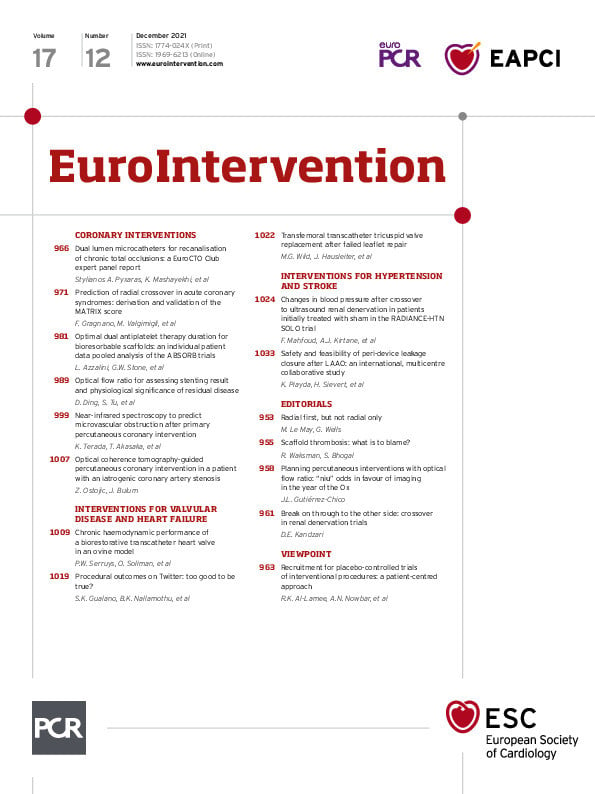Transradial access (TRA) has become the default mode of access for cardiac catheterisation and percutaneous coronary intervention (PCI) in many centres worldwide and is recommended by current guidelines. However, in some clinical situations the procedure cannot be adequately performed via TRA, and transfemoral access (TFA) is needed. Unfortunately, worse clinical outcomes are observed in patients needing crossover1. It is therefore important to understand the factors associated with crossover, since early identification of patients at risk may influence strategies in the catheterisation laboratory.
In this issue of EuroIntervention, Gragnano et al propose a novel and validated risk score for predicting crossover from TRA to TFA among patients presenting with an acute coronary syndrome (ACS) referred for cardiac catheterisation2.
The score was developed using 4,197 patients randomly assigned to TRA in the MATRIX trial3 and subsequently validated using patients assigned to TRA in the RIVAL trial4 (n=3,451) and in the RIFLE-STEACS trial5 (n=491). The rate of crossover in the MATRIX trial was 4.4%, while crossover rates were higher in the RIVAL trial, 7.7%, and in the RIFLE-STEACS trial, 9.6%.
The MATRIX score was developed using the baseline characteristics of the patients and includes the following 8 items: age, height, smoking, renal failure, prior coronary artery bypass grafting (CABG), ST-segment elevation myocardial infarction (STEMI), Killip class and radial expertise.
The derivation of the score fully satisfies 4 of the 7 critical steps identified by Steyerberg and Vergouwe for the development of prediction models6. The first step, problem definition and data inspection, was met with a clear primary endpoint of radial crossover at the index procedure and the clinical variables prospectively collected in a randomised trial. In addition, 3 other steps were met, namely model estimation based on a logistic regression, model performance based on calibration, discrimination and clinical useful measures, and model validation using 2 external validation cohorts.
Meeting the step on the model presentation is demanding, as the model is complex, involving 8 predictors. However, a nomogram plus an online calculator makes the applicability of the model quite feasible.
The other 2 steps, coding of predictors and model specification, are more challenging. The step on coding of predictors collapses Killip class 2, 3 and 4 into a single class due to the low frequency of occurrence of class 3 and 4. Although the MATRIX trial did not exclude patients with cardiogenic shock, only 1.1% of patients assigned to TRA were Killip class 4 at baseline; yet Killip class 4 may be a critical predictor for crossover, and it may be important to consider this class on its own. The continuous variables, i.e., age and height, appear to have a linear association with radial crossover based on the nomogram, whereas a non-linear association may have been anticipated. For example, a difference of 10 years for young patients is probably less important than for older patients.
For the model specification step, the identification of potential predictors based on “previous studies, clinical judgment, and prompt availability in the catheterisation laboratory” is well conceived, although we wonder why diabetes was not considered. Current smoking apparently has a protective effect, which does not seem sensible. An interaction of smoking and age may exist where possibly the prognostic effect of current smoking is less strong for younger than for older patients. In patients with ACS, smoking has been associated with better clinical outcomes, a phenomenon termed the “smoker’s paradox”. Studies have shown that after adjusting for age, the protective effect of smoking disappears7. Finally, patients with STEMI are clearly different. Time to reperfusion is critical for survival and operators are more likely pressed to crossover, as witnessed in the RIFLE-STEACS trial. In these patients, a serum creatinine level needed to identify renal failure, a predictor of radial crossover, may not be readily available at the start of the procedure.
Altogether, the authors should be commended for developing the first externally validated score which promises to be a useful tool in clinical practice. A high MATRIX score, i.e., their cut-off point of 41, could prompt an operator to consider TFA first or alternatively use ultrasound guidance to reduce radial crossover as reported in the RAUST trial8, where ultrasound guidance improved the success and efficiency of radial artery cannulation and significantly reduced crossover rates. The MATRIX score could be integrated in the catheterisation report and extracted into the centre’s catheterisation/PCI database. Just as the APACHE score is now an important metric in the intensive care unit, the MATRIX score could become an important metric in the catheterisation laboratory. It could be used to generate quality reports and measure catheterisation and PCI efficiency. It could be added to case report forms for research purposes and become an important baseline characteristic allowing comparisons between populations studied. For example, it could be used as a benchmark to compare TRA versus TFA in patients at high risk for radial crossovers. Most importantly, it could lead to improve patient care.
Conflict of interest statement
The authors have no conflicts of interest to declare.
Supplementary data
To read the full content of this article, please download the PDF.

